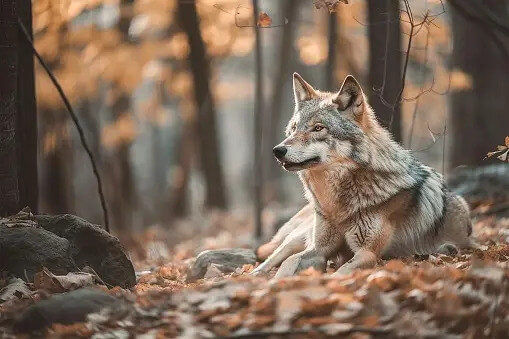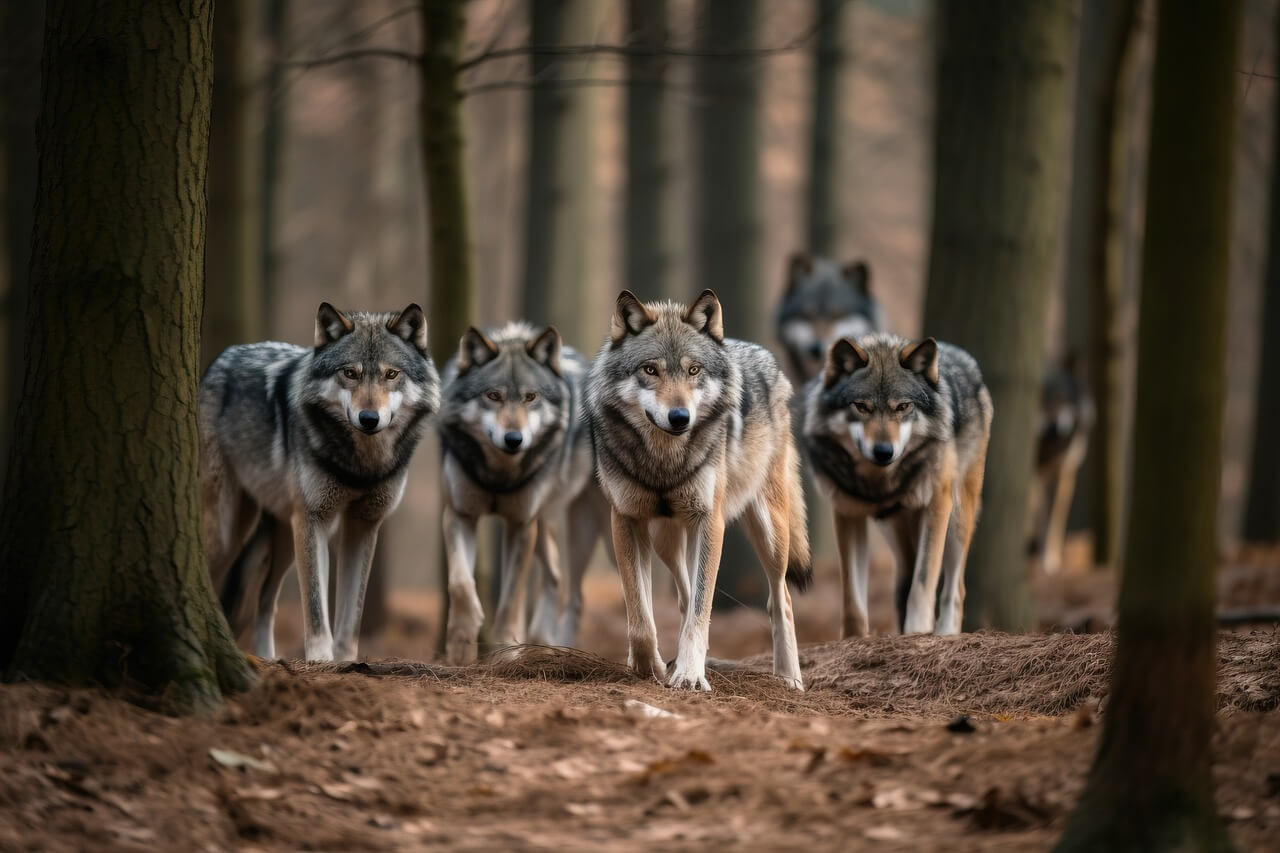Curious about what goes on in the mysterious world of wolves? Well, you’re in for a treat! In this article, we’ll explore the captivating eating habits of these majestic creatures and unravel the secrets behind what they truly feed on. From forests to tundras, wolves are known to reside in various habitats worldwide. But what exactly fuels their predatory instincts?
Wolves are carnivorous creatures, and their diet mainly consists of meat. They are skilled hunters and have a diverse range of prey, including large herbivores such as elk, deer, and moose. These animals provide the wolves with the necessary nutrients to survive and thrive. However, wolves are opportunistic feeders and are not limited to just large prey. They are known to go after smaller mammals like rabbits and rodents, as well as birds, fish, and even insects when necessary.
Join us in this fascinating exploration as we delve deeper into the dietary preferences of wolves and understand the integral role their eating habits play in maintaining the balance of nature’s ecosystem. Stay tuned to discover more about these enigmatic creatures and their extraordinary feeding choices.
The role of diet in wolf behavior and survival
Wolves are carnivorous creatures, and their diet mainly consists of meat. Their eating habits play a crucial role in their behavior and survival. A wolf’s diet provides them with the necessary nutrients to survive and thrive, impacting their physical health, reproductive capabilities, and overall strength.
Understanding the dietary preferences of wolves is essential to comprehending their ecological role and the intricate balance of nature’s ecosystem. Join us as we embark on a journey to discover the fascinating world of wolf feeding habits.
What do wolves eat in the wild?

Wolves are skilled hunters and have a diverse range of prey. In the wild, their primary targets are large herbivores such as elk, deer, and moose. These animals provide the wolves with substantial amounts of meat and nutrients. Their hunting techniques and strategies are honed through centuries of evolution, allowing them to take down formidable prey.
However, wolves are opportunistic feeders and are not limited to just large prey. They also go after smaller mammals like rabbits and rodents, ensuring a steady food supply. Additionally, wolves have been observed hunting birds, fish, and even insects when necessary. Their adaptability and versatility in hunting enable them to survive in various environments.
Must Read:- 30 Types of Wild Dogs with Species & Images (In-depth Guide)
Understanding the hunting techniques of wolves
Wolves are highly intelligent predators and employ a variety of hunting techniques to capture their prey. One of the most well-known hunting strategies is the pursuit and chase technique. Wolves work together as a pack, using their exceptional endurance and teamwork to exhaust their prey. They coordinate their movements, taking turns to lead the chase and wear down the targeted animal until it succumbs to fatigue.
Another technique employed by wolves is the ambush strategy. They hide in the surrounding vegetation, waiting patiently for an opportunity to strike at unsuspecting prey. This method requires stealth, patience, and precise timing. Once the moment is right, the wolves launch a surprise attack, swiftly overpowering their prey.
The importance of pack dynamics in wolf feeding
Pack dynamics play a crucial role in wolf feeding habits. Wolves are social animals and live in tight-knit family units known as packs. These packs consist of an alpha pair, their offspring, and other related wolves. Hunting is a collective effort, and the pack works together to bring down larger prey. The alpha pair leads the hunt, while the other pack members assist in the chase and capture.
Pack dynamics also extend to the allocation of food within the group. The alpha pair and their offspring are typically the first to feed, ensuring the survival and well-being of the younger members. Once they have finished, the other members of the pack take their turn to eat. This hierarchy ensures the efficient distribution of resources and strengthens the unity of the pack.
How wolf diet varies across different regions?
The diet of wolves can vary depending on the region they inhabit. Wolves adapt to their environments and make the most of available food sources. In areas where large herbivores are abundant, such as forests and grasslands, wolves primarily rely on elk, deer, and moose as their main food source.
In contrast, in regions with a scarcity of large prey, wolves turn to smaller mammals like rabbits and rodents. They are also known to target birds, fish, and insects, supplementing their diet when necessary. This adaptability enables wolves to survive in diverse ecosystems, showcasing their ability to thrive even in challenging environments.
The impact of human activities on wolf food sources
Human activities have had a significant impact on wolf food sources. Habitat destruction, deforestation, and urbanization have led to a decline in the availability of suitable hunting grounds for wolves. This loss of habitat has resulted in a decrease in the population of prey animals, disrupting the delicate balance of the ecosystem.
Furthermore, human encroachment into natural habitats has caused conflicts between humans and wolves. This conflict often leads to the extermination of wolves to protect livestock, further reducing their food sources. It is essential to recognize the impact of our actions on the natural world and work towards conservation efforts that preserve the delicate balance of predator-prey relationships.
Conservation efforts to protect wolf food sources
Conservation efforts are critical in protecting wolf food sources and ensuring the survival of these magnificent creatures. Measures such as habitat preservation, reforestation, and the establishment of protected areas help maintain the population of prey animals. By safeguarding the natural habitats of wolves and their food sources, we can contribute to the preservation of biodiversity and the overall health of ecosystems.
Additionally, raising awareness about the importance of wolves and their role in the ecosystem is crucial. Education initiatives and campaigns can help dispel misconceptions and promote coexistence between humans and wolves. By understanding the value of these apex predators, we can foster a greater appreciation for their feeding habits and the vital role they play in maintaining a healthy environment.
Studying wolf scat: Insights into their diet
One method researchers employ to gain insights into wolf feeding habits is the study of their scat, also known as feces. Wolf scat provides valuable information about their diet, allowing scientists to understand the types of prey they consume. By analyzing the remains of bones, fur, and plant matter found in the scat, researchers can paint a clearer picture of the wolves’ feeding preferences and the ecological interactions within their environment.
Studying wolf scat also helps identify any potential changes in their diet caused by human activities or environmental factors. This information is crucial in assessing the impact of these changes on wolf populations and the overall balance of the ecosystem.
Must Read:-
- [Top 10 Birds in Africa]
- Are Wolves the Ultimate Meat Lovers?
- Exploring the World’s 10 Rarest Animals
- The Biggest Eagles in the World!
Conclusion: Appreciating the complexity of wolf feeding habits
In conclusion, the eating habits of wolves are both captivating and essential to their survival. These carnivorous creatures rely on a diverse range of prey to meet their nutritional needs. From large herbivores to smaller mammals, birds, fish, and insects, wolves adapt their diet to the available food sources in their environment.
Understanding the hunting techniques, pack dynamics, and regional variations in their diet provides valuable insights into the complex web of predator-prey relationships. As humans, it is our responsibility to protect the habitats and food sources that wolves depend on. By doing so, we can ensure the continued existence of these enigmatic creatures and appreciate the vital role they play in maintaining the harmony of nature’s ecosystem.
Join us in our quest to unravel the mysteries of wolf feeding habits and deepen our appreciation for the wonders of the natural world. Together, let’s celebrate the resilience and adaptability of these majestic creatures and work towards a future where they can thrive alongside us in harmony.

